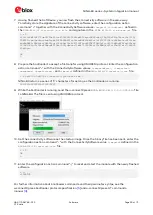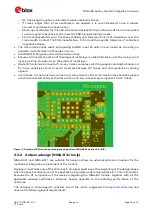
NINA-B3 series - System integration manual
UBX-17056748 - R13
Design-in
Page 34 of 72
C1-Public
o
RF trace length must be minimized to reduce dielectric losses.
o
If traces longer than a few centimeters are needed, it is recommended to use a coaxial
connector and cable to reduce losses.
o
Stack-up should allow for thick 50
traces and at least 200
µ
m of trace width is recommended
to ensure good impedance control over the PCB manufacturing process.
o
FR-4 material exhibits poor thickness stability and thus less control of impedance over the
trace length. Contact the PCB manufacturer to find out the specific tolerance of controlled
impedance traces.
•
The transmission lines width and spacing to GND must be uniform and routed as smoothly as
possible: route RF lines in 45° angle or in arcs.
•
Add GND stitching vias around transmission lines.
•
Ensure solid metal connection of the adjacent metal layer on the PCB stack-up to the main ground
layer, providing enough vias on the adjacent metal layer.
•
Route RF transmission lines far from any noise source (as switching supplies and digital lines) and
from any sensitive circuit to avoid crosstalk between RF traces and Hi-impedance or analog
signals.
•
Avoid stubs on the transmission lines; any component on the transmission line should be placed
with the connected pad over the trace. Also avoid any unnecessary component on RF traces.
Figure 11: Example of RF trace and ground plane design from NINA-B3 Evaluation Kit (EVK)
3.3.2
Antenna design (NINA-B3x1 only)
NINA-B301 and NINA-B311 are suitable for designs where an external antenna is needed for the
mechanical integration or placement of the module.
Designers must take care of the antennas from all perspectives at the beginning of the design phase
when the physical dimensions of the application board are under analysis/decision. This is important
because the RF compliance of the device integrating the NINA-B3 module, together with all the
applicable required certification schemes, heavily depends on the radiating performance of the
antennas.
The designer is encouraged to consider one of the u-blox suggested
observe the following layout requirements.
















































